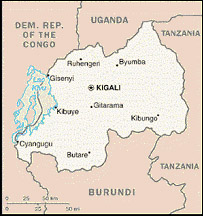 GOVERNMENT GOVERNMENT |

Type: Republic.
Independence: July 1, 1962.
Constitution: June 10, 1991.
Branches:
- Executive-president (chief
of state), prime minister (head of war for transition
to multi-party parliamentary democracy
- Legislative-National Assembly.
- Judicial-Supreme Court, Constitutional
Court, Council of State, Court of Appeals.
Administrative subdivisions: 12 provinces,
106 districts.
- Butare
- Byumba
- Gikongoro
- Gysenyi
- Gitarama
- Kibungo
- Kibuye
- Kigali (Ville)
- Kigali-Ngali
- Mutara
- Cyangugu
- Ruhengeri
Suffrage: Suspended.
- Political parties: Five parties comprise
the government:
- Rwandan Popular Front (RPF),
- Democratic Republican Movement (MDR),
- Social Democratic Party (PSD),
- Liberal Party (PL), and the
- Christian Democratic Party (PDC).
RWANDA GOVERNMENT
President of the Republic of Rwanda: Paul
Kagame
Prime Minister: H.E. Bernard MAKUZA
Table
of ministers |
 GOVERNMENT
AND POLITICAL CONDITIONS GOVERNMENT
AND POLITICAL CONDITIONS |
In all countries, institutions of governance exert
primordial influence over a society's stability,
prosperity, and the well being of its citizens.
The long-term stability of governance, in turn,
is heavily dependent upon citizen "buy-in,"
that is, the people's belief in the justness and
fairness of their governing institutions.
In Rwanda, the genocide and its attendant destruction
were orchestrated by an authoritarian and centralized
state. The consequence were many:
1.The human resource base, including most trained
professionals, was decimated trough death or flight.
2.Government buildings were looted and destroyed.
3.Government documents, achieves and databanks were
lost.
4.Government institutions, generally, lost all credibility.
After its military victory in July 1994, the RPF
organized a coalition government similar to that
established by President Habyarimana in 1992. Called
The Broad Based Government of National Unity, its
fundamental law is based on a combination of the
constitution, the Arusha accords, and political
declarations by the parties. The MRND Party was
outlawed. Political organizing is banned until 2003.
The biggest problems facing the government are reintegration
of more than 2 million refugees returning from as
long ago as 1959; the end of the insurgency and
counter-insurgency among ex-military and Interahamwe
militia and the Rwandan Patriotic Army, which is
concentrated in the north and south west; and the
shift away from crisis to medium- and long-term
development planning.
 DEFENSE DEFENSE
|
The military establishment is comprised of an army
and a paramilitary gendarmerie. Defence spending
continues to represent a disproportionate share
of the national budget, largely due to continuing
security problems along the frontiers with the Democratic
Republic of the Congo and Burundi in the aftermath
of the war. The government has launched an ambitious
plan to demobilize thousands of soldiers.
 FOREIGN
RELATIONS FOREIGN
RELATIONS |
Rwanda has been the center of much international
attention since the war and genocide of 1994. Rwanda
is an active member of the UN, having presided over
the Security Council during part of 1995. The UN
assistance mission in Rwanda, a UN chapter 6 peacekeeping
operation, involved personnel from more than a dozen
countries. Most of the UN development and humanitarian
agencies have had a large presence in Rwanda.
At the height of the emergency, more than 200 non-governmental
organizations were carrying out humanitarian operations.
Several west European and African nations, Canada,
China, Egypt, Libya, Russia, The Vatican, and the
European Union maintain diplomatic missions in Kigali.
|

